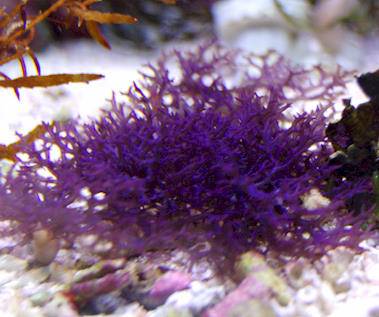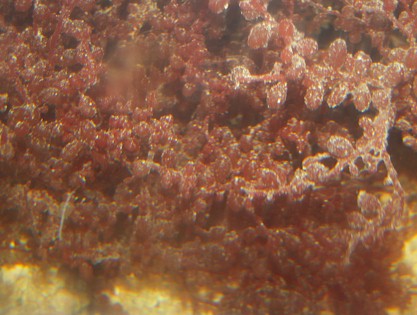|
In
the marine aquarium there are three main types of filtration that
are essential to a clean and stable environment. They are
mechanical, biological and chemical. There are many commercially
available products that combine these in one unit, such as
canister filters, power filters and trickle filters but most are
not suitable for a marine planted aquarium. Many of these designs
will become nutrient sinks in time and can release large amounts
of nitrates and phosphates into the aquarium water. While flow-through filters may be beneficial for some heavily planted
aquariums and even necessary, generally it will create conditions
favorable for excessive, undesired micro algae growth without
regular cleaning of filter material. Maintaining an aquarium with
marine macro algae and plants is often a balancing act between
controlling the buildup of nitrates and organic material and
providing just enough for a healthy ecosystem.
Mechanical
Filtration
 For
the marine planted aquarium the use of some form of mechanical
filtration is normally needed. Plant material in time will break
down to form sediments that can become nutrient sinks over time,
especially in smaller aquariums. Some of this organic material
will break down and be consumed by both macro algae and sea
grasses but will also encourage micro algae growth. Depending on
the size of the system these include the use of foam filter pads,
micron filters and sock filters. Filter material should be cleaned
or replaced often as they get dirty quickly in marine plant
dominated systems. Protein Skimmers are very efficient at removing
organic material and can be used in large systems that have a
substantial bio-load. Some models are better than others, but most
available today will produce good results. Over skimming can
remove beneficial organisms, so running a skimmer continuously in
a marine planted tank is not desirable as it will remove too many
nutrients that the plants need to grow. For
the marine planted aquarium the use of some form of mechanical
filtration is normally needed. Plant material in time will break
down to form sediments that can become nutrient sinks over time,
especially in smaller aquariums. Some of this organic material
will break down and be consumed by both macro algae and sea
grasses but will also encourage micro algae growth. Depending on
the size of the system these include the use of foam filter pads,
micron filters and sock filters. Filter material should be cleaned
or replaced often as they get dirty quickly in marine plant
dominated systems. Protein Skimmers are very efficient at removing
organic material and can be used in large systems that have a
substantial bio-load. Some models are better than others, but most
available today will produce good results. Over skimming can
remove beneficial organisms, so running a skimmer continuously in
a marine planted tank is not desirable as it will remove too many
nutrients that the plants need to grow.
Biological
Filtration
The
best form of biological filtration for any marine system is the
use of live rock or coral rubble. Live rock is full of organisms and bacteria that naturally filter aquarium water by consuming and
converting nutrients and breaking down harmful elements through
de-nitrification. Live rock is natural, attractive and provides a
surface for marine plants to anchor and thrive. Uncured live rock
is the best choice if it is cured properly because it will contain
much more life than cured live rock. Aqua cultured live rock,
although sometimes more dense than wildly collected rock, offers the
hobbyist with the most variety of marine life, including beneficial
bacteria, invertebrates and macro algae. External or internal
pumps provide water circulation which is important for live rock
to function. The size of the system and its inhabitants will
dictate how much flow is ultimately needed.
Chemical
Filtration
There
are three main types of chemical media that are used to filter
aquarium water. They are activated carbon, phosphate absorbing,
and nitrate absorbing media. The use of activated carbon to
chemically filter aquarium water has long been the preferred choice in both
fresh and salt water aquariums. Although it can be useful in a
marine planted aquarium, carbon should be used sparingly as it
also can remove needed compounds and nutrients from the aquarium
water. Phosphate and nitrate removing media can be used when
levels get out of control but should be removed at the recommended
interval so that the nutrients do not leach back into the aquarium
after they have out lived their ability to absorb nutrients. A
deep sand bed can also be utilized in a planted tank to control
the amount of nitrate through the formation of anaerobic bacteria
deep within the sand bed. Most deep sand beds need to be 6"
or so to be effective however as too little depth can create a
toxic mess. Overall nitrate is needed by all marine plants and
depending on the rate of growth its presence in low levels is
beneficial to the health of the system.
 Aquarium
water for use with a marine aquarium is made by dissolving salt
mix with either purified water or tap water. The composition of
household tap water varies greatly depending on what region the
hobbyist resides. Tap water can be hard or soft, alkaline or
acidic and contain variable amounts of other elements. Most salt
mixes in the industry are composed of all naturally occurring elements found in natural seawater. Purified water is the best
choice for any marine system as it removes 99% of contaminants and
nutrients from the water. Sources of purified water include
demineralized, reverse osmosis/deionization, and distilled water.
In some cases tap water can be treated chemically and used in a
marine planted aquarium. This is done with large scale aquaculture
as the excess nutrients are quickly consumed by the plants. For
most aquariums, purified water is the best choice and will help to
drastically reduce unwanted algae blooms and harmful elements. If
you live near the ocean, natural seawater can be used,
but can often add unwanted bacteria, pathogens and free floating
algae to an aquarium if not treated. This can cause problems long
term. Water changes are very important when
maintaining a marine planted aquarium and help to remove nutrient
rich water and replenish elements lost that were absorbed by the
plants. The buildup of sediment on several species of macro algae
such as Botryocladia (pictured) can be avoided by regular
water changes, increased flow and mechanical filtration
methods. Aquarium
water for use with a marine aquarium is made by dissolving salt
mix with either purified water or tap water. The composition of
household tap water varies greatly depending on what region the
hobbyist resides. Tap water can be hard or soft, alkaline or
acidic and contain variable amounts of other elements. Most salt
mixes in the industry are composed of all naturally occurring elements found in natural seawater. Purified water is the best
choice for any marine system as it removes 99% of contaminants and
nutrients from the water. Sources of purified water include
demineralized, reverse osmosis/deionization, and distilled water.
In some cases tap water can be treated chemically and used in a
marine planted aquarium. This is done with large scale aquaculture
as the excess nutrients are quickly consumed by the plants. For
most aquariums, purified water is the best choice and will help to
drastically reduce unwanted algae blooms and harmful elements. If
you live near the ocean, natural seawater can be used,
but can often add unwanted bacteria, pathogens and free floating
algae to an aquarium if not treated. This can cause problems long
term. Water changes are very important when
maintaining a marine planted aquarium and help to remove nutrient
rich water and replenish elements lost that were absorbed by the
plants. The buildup of sediment on several species of macro algae
such as Botryocladia (pictured) can be avoided by regular
water changes, increased flow and mechanical filtration
methods.
|
|
PH Natural
seawater has a PH of 8.4. While most marine plants and organisms
can survive in a wide range, it is best to strive to maintain a
level as close as possible to natural conditions. An elevated ph
can help reduce the growth of certain micro algae as many prefer a
more acidic environment.
Alkalinity Alkalinity
is the measurement of water's ability to neutralize acids. The
alkalinity of sea water keeps ph stable and a drop in alkalinity
will lead to an eventual drop in ph. Most aragonite sand and salt
mixes are sufficient to properly buffer aquarium water containing
primarily marine plants. Again, water changes are essential for
optimal health in any marine aquarium.
Temperature Most
tropical species of marine plants can survive in a wide range of
temperatures from about 72 degrees to 86 degrees. Some species
found in both tropical and sub tropical environments grow in
seasons however and have a distinct preference for certain water
temperatures. Green macro algae such as Ulva and Codium are
temperate species that prefer cooler water temperatures and will not survive
very long in the
aquarium above 80 degrees. Sea grasses begin a dormant stage when
the water temperatures are in the low to mid 60's and although
remain alive, they will not grow. In the marine aquarium a range
of 76 to 80 degrees is acceptable and should not present any
problems for most tropical and sub tropical macro algae and sea
grasses.
Salinity
Slight
differences in salinity doesn't seem to have a negative effect on the
photosynthesis and growth of most marine plants. Many varieties of sea
grass can also adapt to very large swings in salinity in their natural
environment. The change however, must be gradual, as a drastic
change in salinity can cause most marine macro algae to undergo
the process known as sporulation. When adding fresh water to an
aquarium containing marine plants, especially Caulerpa, be careful
not to change the overall salinity of the tank too quickly.
Specific gravity levels in a marine aquarium are normally 1.024 -
1.026, but marine plants can survive in slightly higher ranges if
desired.
Water
Circulation The
ocean is a dynamic and constantly changing environment, currents,
tides and storms produce enormous amounts of exposure to plants,
coral and fish. Water movement is very important for the growth of
all marine plants in the aquarium. It aids in the removal of
sediment, prevents some epithetic growth and provides increased
diffusion of nutrients. Species such as Halymenia greatly benefit
from strong flow to maintain their slippery fleshy fronds. How
much flow is needed depends on the size of the system, but in
general most plants can handle large amounts of movement.
|